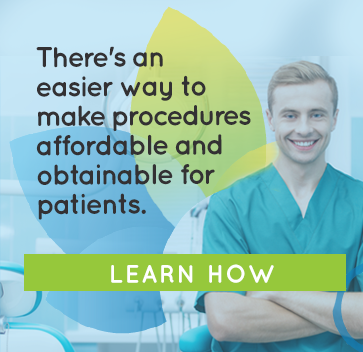By Terilyn Paulgaard on Jan 17, 2019 1:01:00 PM
An aspiring beauty queen gets a shot at a crown. An impoverished young boy dies because of a tooth. A revolutionary dentist helps Judy Garland and Shirley Temple rise to super-stardom. The anecdotes go on, all meticulously supported by data from reliable sources. The result is a New York Times reviewed book that was named one of NPR’S BEST BOOKS OF 2017. TEETH is entertaining, well-written and filled with information that drives home one critical point: affordable dental financing for patients is essential for a healthy population.
How much has changed since TEETH was published? Did the book have any effect on affordable dental financing for patients? To get these answers—and more—we turned to the MARY OTTO, the author, for a Q and A regarding dentistry in the U.S.
What was the impetus to writing TEETH? Was there one specific incident or revelation that led you to write it?
OTTO: I first started writing about oral health back in 2007 when I was working as a reporter for the Washington Post. I covered the story of 12-year-old Deamonte Driver, a Maryland boy who died after suffering complications from a dental abscess. His mother had actually been seeking dental care for his brother when Deamonte got sick, but the children were covered by Medicaid and participating dentists were very hard to find in their community. Deamonte’s death led to Congressional hearings into the shortage of dental care for Medicaid children and major reforms in the state of Maryland.
Since the publication of TEETH, what kind of response have you received from policy-makers? From people in general? From the dental community?
OTTO: People from across these areas have told me that they were grateful for the book. They have said it has been useful to them to have a journalist’s look at the state of oral health in America; how the system evolved, where it breaks down and what research and reporting reveal about the nation’s dental divide. Some also say it has been helpful to have a book written for general readership that explores oral health as a social issue. Others have told me they have brought copies of the book to their lawmakers to raise awareness about the importance of access to dental care.
Are there any developments in dental care affordability that have been implemented due to TEETH? If so, what are those developments and if not, what’s prevented those developments?
OTTO: I think change has continued to unfold, driven by forces and conversations that are far larger than the book. Since TEETH was published, workforce innovations have been launched, Medicaid dental benefits have been expanded and community health clinics have added dental care to the services they offer. Health officials and leaders in states and communities seem increasingly aware of the importance of dental care. They say they are hopeful that changes like these may offer cost-efficient ways to get preventive care to wider populations, bringing down overall health care expenses.
Are there any parts of your book—any of the policy platforms, personal stories, situations you described—that you feel need updating as we enter 2019?
OTTO: I just did a few updates for the paperback edition, due out in June. Access to care for Medicaid children has inched up; so has dental benefit coverage overall. And in 2018, two more states–Arizona and Michigan--approved mid-level dental workers.
Is there new information about affordable dental care that you’d like to bring to the attention of the dental community?
OTTO: There seems to be continuing interest in the idea of adding a routine dental benefit to Medicare, which covers more than 50 million elderly and disabled Americans. As the oral health topic leader for the Association of Health Care Journalists I write a regular blog on dental issues for our members. That is one of the stories I am continuing to watch.
Two years after TEETH, what do you see as the solution to bridging the gap between “the haves” and “the have-nots” regarding good oral health?
OTTO: Well, I am just a journalist, but Dr. David Satcher, who issued the landmark Oral Health in America report in 2000, called for the building of an American healthcare system that “meets the oral healthcare needs of all Americans and integrates oral health effectively into overall health.” Overcoming the historic divide between dental care and the rest of health care and reaching the one-third of Americans who currently experience significant barriers in obtaining care remains a complex challenge that continues to engage health leaders.
What role should the government play in providing dental care to the public? If you believe the government has a role, where should the revenue come from?
OTTO: Government already plans a big role in providing dental care to the public. More than 30 million child Medicaid beneficiaries are entitled by law to dental benefits. Access has improved in recent years. Still nearly half of Medicaid children do not get dental care. More than 30 million adults are also covered by Medicaid, though adult dental benefits are considered an optional part of the program and vary from state to state. Medicare, which provides a wide range of health care benefits to more than 50 million elderly and disabled Americans, has never included routine dental coverage, but there is some talk of adding it. There is a lot of discussion now about the costs of all these programs. At the same time there is also discussion of the social and economic costs associated with going without dental care. Studies show that children who suffer from dental pain have trouble in school. Adults with missing teeth face challenges getting jobs. Seniors with untreated oral disease have trouble eating healthy food. Roughly one million Americans a year show up in emergency rooms with non-traumatic dental problems. They really don’t get the care they need in emergency rooms but the visits cost roughly $1 billion annually.
What steps do you feel should be taken to reunite the dental professional with the medical profession? Have you had any feedback from medical doctors regarding the link between dental health and medical (and psychiatric, for that matter) health?
OTTO: On my travels since the book came out I have visited dental schools where innovative efforts are being made to encourage students to engage in team work across health care professions with a goal of providing more holistic care to patients. I have also met providers who are excited about the inter-professional work they are doing in Federally Qualified Health Centers. They are finding ways to work together to offer dental, mental and primary care.
Everyone here at COMPASSIONATE FINANCE appreciates Mary Otto’s work in the field of affordable dental care for all citizens. We try to do our part by providing flexible, patient-friendly dental financing to as many people as possible. To discuss what we can do for you, please contact us at (866) 964-4727.
You can contact Mary Otto at mary@healthjournalism.org
For book information, or to inquire about the hard-cover version which is now available or the soft-cover version available in June, please go to https://thenewpress.com/books/teeth
To follow Mary Otto’s on-going investigations, please go to: https://healthjournalism.org/blog/author/mary-otto/






comments